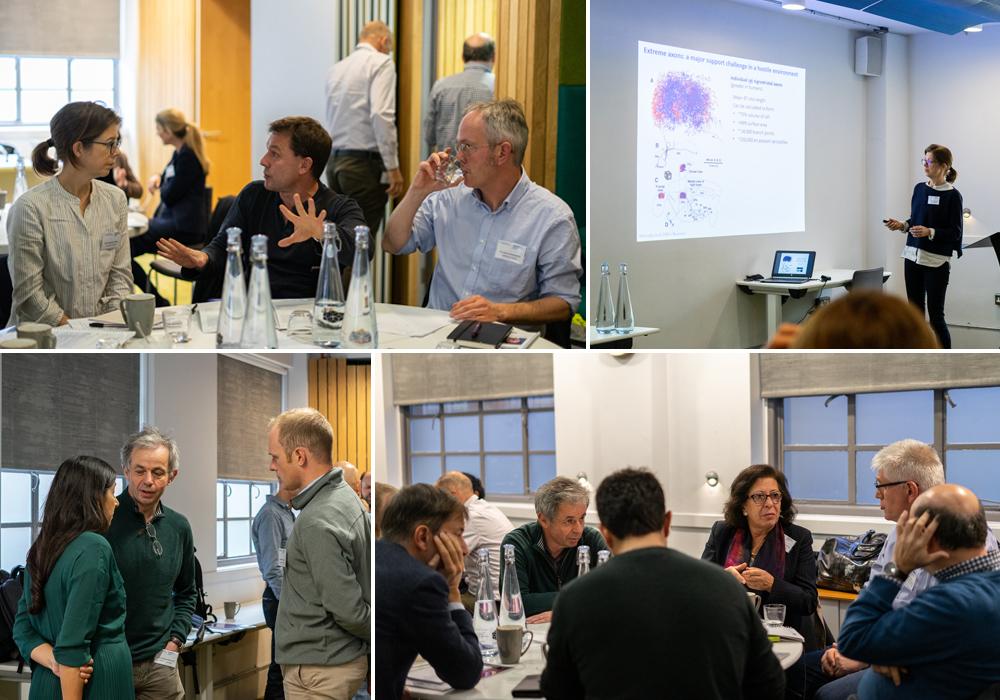With the UK’s prevalence of Parkinson’s disease (PD) expected to almost double by 2065, the need for breakthroughs in disease-modifying treatments, as with other neurodegenerative disorders, is imperative. On 29 October UK DRI convened over 40 PD experts to London for an interactive workshop, co-hosted with Parkinson’s UK, in order to examine the latest developments and identify initiatives that could transform the field.
Latest findings
Several high-profile researchers presented the newest findings from their labs including further investigation into pathways involving LRRK2 (Dario Alessi) and PINK1 (Miratul Muqit), effects of a-synuclein oligomers in patient-derived iPSCs (Sonia Gandhi) and strategies to uncover reasons for dopaminergic neuron vulnerability in the disease (Stephanie Cragg).
In the afternoon Mina Ryten and Caleb Webber delved into insights from genetic risk analysis and Tom Stoker gave an update on trials using cell-based therapies. A particular highlight came from Michele Hu who described patients with REM Sleep behaviour disorder (RBD), many of whom convert to PD and offer an interesting cohort for therapeutic trials. Attendees agreed that integrating patient studies would aid understanding of disease progress and mechanisms behind resilience.
Short flash presentations touched on new animal models, further understanding from drug screening in iPSC lines and influence from the immune system.
Challenges to research and therapeutic success
For those who regularly attend meetings across the neurodegenerative disorders, the hot topics and challenges facing the PD field, many discussed at the workshop, may not sound all too unfamiliar.
Accumulating evidence points to inflammation playing a key role in disease progression with questions remaining on time windows and benefits of ‘turning off/on’. Some attendees questioned why trials targeting inflammation in PD should be any different from unsuccessful predecessors in AD, with suggestions including need for better patient stratification.
There was discussion around current animal models for PD and whether they aim to mimic cause or progression of the disease. This is an important issue considering that the genetic risk is likely to differ in these two circumstances. However, it was noted that monogenic models are tractable and therefore still useful when studying the sporadic form, particularly when targeting early disease changes.
Common disease mechanisms such as inflammation, misfolded protein aggregation and synaptic dysfunction exist across the neurodegenerative disorders, and research focus on these is a priority for UK DRI research groups. However, with these similarities, the impact of heterogeneity should not be forgotton when seeking out viable therapeutics - two individuals sharing similar PD symptoms may have very different root causes and therefore reaction to treatment. Going forward, this heterogeneity should be taken into account when designing animal models and recruiting for clinical trials - likely through genetic screening.
Many at the workshop urged focus on other cells types too, for example, considering cortical neuron vulnerability and the appearance of a-synuclein in astrocytes before dopaminergic neurons. Inducing aggregation in other cells types and monitoring effect would be important. Furthermore, investigations continue into the spread of pathological proteins and which exact species are detrimental.

experts in Parkinson's disease joined the workshop to share ideas
Initiatives to drive forward the field
As part of the workshop, the researchers present were asked to think of platforms or initiatives that are currently missing from the field. A major goal of the UK DRI is to identify where technology or resource investment could make a large impact in our advancement towards effective therapeutics.
For many, generating a series of knock-in mice with the same background would be hugely valuable for systematic analysis of PD-associated mutations, allowing researchers to decipher the level and type of contribution to disease. A patient-derived IPSC library would complement these studies in vitro, although there is good progress in this area. This resource could additionally be utilised to investigate genotype-phenotype correlation.
Others suggested that a systematic analysis of protein expression across the PD brain and in animal models would be useful, particularly the interactions shared between pathways. Identifying these would increase opportunities for therapeutic targeting. A PD brain atlas would also assist in bringing greater understanding to region-specific vulnerability.
To efficiently identify patients for trials and track disease progression, the PD field, as with other neurodegenerative diseases, requires robust non-invasive biomarkers. Further effort should be focused on development here, perhaps by taking samples from slow/intermediate/fast progressors to explore disease mechanisms. A trial-ready UK-wide database could additionally act as a foundation for a national programme to stratify patients.
Other topics that emerged included better modelling of influences such as age, vasculature dysfunction and sex.
Next steps
We would like to thank all those who came to the workshop and contributed to the ideas and discussion. Over the coming months, UK DRI will be assessing the initiatives proposed and needs of the Parkinson's disease field, in order to fill gaps with strategic recruitment and resource development. If you have any further comments or discussion related to our work on Parkinson's ideas, please contact Dr Giovanna Lalli (Director of Scientific Affairs).
Article published: 02 December 2019
